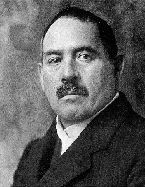
Lovis Corinth was born on July 21, 1858, at Tapiau in eastern Prussia. As a child he sought relief from his hostile brothers and sisters by drawing. His ability was noticed by his father, a master tanner, who sent him to study art in Koigsberg on the Baltic.
At the age of 20, Corinth went to the Munich Academy, and at 26 to Paris, where he took lessons at the Academie Julian and painted mostly portraits. He was unmoved by what he saw of Impressionism in Paris, but admired the realism of a painting by Wilhelm Leibl, The Poachers, that was on view there. Corinth's stylistic masters at the time were Rembrandt, Rubens, Frans Hals, Velazquez, and the realist par excellence, Gustave Courbet. When Corinth was in Paris more than 20 years later, he went daily to the Louvre.
He left Paris in 1887, lived for a short time in Berlin, and then, apart from frequent journeys in Germany, Switzerland, and Denmark, he settled in Munich until 1900. The enjoyable life he had in Berlin was mirrored in the work he did there, which grew richer and brighter as he laid his pigments more thickly and freely. He opened an art school, and married one of his first pupils. With Max Liebermann he became one of the leaders of German Impressionism, though his vision remained closer to that of Rembrandt than to that of any of the French Impressionists. When he visited Holland in the early years of the 20th century, he still sought out and studied the works of Rembrandt and Hals.
Corinth was partly incapacitated by a stroke in 1911, but quickly recovered and in 1919 he built a house on the Walchensee, the scene of much of his later work. His style became much looser during his last years, and in about 1916 his color, in paintings now expressionist in feeling, became brighter and richer. A few months before his death in July, 1925, in Holland, he wrote: "I have discovered something new: true art is the representation of the unreal."
Corinth won recognition first in France, then in Germany. He showed at the Paris Salon in 1884 and won an honorable mention there six years later. In 1911 he was elected chairman and in 1915 president of the Berlin Sezession, where his 60th birthday was celebrated in 1918. He was awarded the freedom of his birthplace, Tapiau; an honorary doctorate at the university of Konigsberg, where there was a large Corinth exhibition the year before he died; and honorary membership of the Munich Academy.